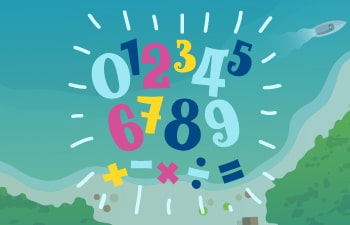It’s the start of the homeschool year and you want your child to be on top of their math and science game! Be sure to add some hands-on activities in your homeschool schedule to keep your students engaged. Below are several ideas to get you started:
Hands-On Science Activities
- Grab a few items from your house like a small toy, bar of soap, empty plastic bottle and construct a hypothesis as to whether it will sink or float. Next, fill a tub or sink with water and conduct your experiment. What were the results?
- How long do you think it will take an ice cube to melt outside? In your refrigerator? In a cup on your counter? Make predictions and then get your stopwatch and find out. Once you’re done, record the data and compare. What do you think affected the results?
- What’s the forecast? Create a weather log for a few weeks and include important information like temperature, humidity, precipitation, and wind speed. Learn to convert Fahrenheit to Celsius and vice versa. Take it a step further and find out what kind of tools Meteorologists use to help them predict the weather.
- Come up with a recipe for the whole family to enjoy. Maybe a comforting soup, healthy salad, or tasty dessert. Find out which fruits and vegetables are in season and grab your apron. Be sure to include the necessary ingredients, measurements, and instructions.
- Since the weather will soon start to cool down, do some research to find out what the coldest places are in the United States and around the world. Create an infographic with facts like coldest temperature ever reached, type of climate, average annual snowfall, and native plants and animals.
Printable Math Worksheets
Looking for more ways to introduce math into your homeschool? Download this printable math packet for K-12 students and start practicing or advancing your math skills today.
Hands-On Math Activities
- At the beginning of the school year, add items such as pebbles, coins, or beads to a jar. Once the year is over, estimate how many you’ve collected and then count the items to see how well you fared.
- The next time you have pizza, practice your fractions. Identify quarters, thirds, and equivalent fractions as you eat, then try adding and subtracting to discover new fractions.
- Shapes are all around: at home, the park, the grocery store. When you find one, identify it: square, triangle, hexagon, then count the angles and determine if they are right angles, acute, or obtuse.
- Going on vacation in the next few months? Whether you’re flying or driving, find out what the total number of miles is that you’ll be travelling. You can also locate your destination on a map and write down the GPS coordinates. Not going on vacation? Pick three places you’d like to travel to and find out the same information.
- Create a pie graph or bar chart detailing the extracurricular activities you plan on doing this year. Maybe you want to spend 40% of your time playing sports, 20% learning a new instrument, 30% with your homeschool group or co-op, and 10% volunteering. Don’t forget to include a title, key, and of course, data. Once the year is over, create another one with how you actually spent your year and compare the two.
Looking for More Math and Science Activities?
While there are many online games available, many of them are full of potentially dangerous ads and not age-appropriate for elementary school students. But Time4MathFacts educational games are ad-free and age-appropriate! These math games are entertaining and excellent at keeping kids engaged. And the longer your kids are engaged and practicing their math, the better chance they have at mastering math fact fluency.
For a more structured program, check out Time4Learning’s PreK-12th online math curriculum and online science curriculum that helps your child develop their skills with interactive, student-paced lessons and activities.
Explore these math and science learning activities:










